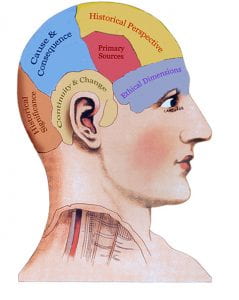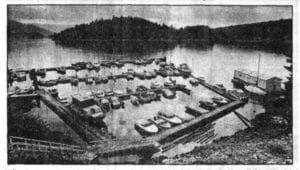“Unpredictability” is defined as the “inability to predict something ever-changing”. Recently, I have realized that this word is in constant circulation, spanning many different topics. Although taken at face value it is not innately negative, I rarely find a way to use its positive counterpart. In some ways, everyone is reaching out for that last shred of certainty to grasp during this trying time.
Driving Question: How can we as historians uncover and share stories about our community?
Our first project this year in PLP was the ”Marking History” project. For this project, we were required to research the history of Deep Cove and use primary source materials to learn about the experiences and perspectives of multiple community members in relation to specific historic events. We were then asked to create a way to share our research with our local community. When this project was first pitched, I was very excited to be working with the Deep Cove Heritage Society, where we would able to access their resources and collaborate during critique and revision.
We started this project by learning about perspective and bias. In class, we had a relatively long discussion on bias and how it relates to perspective. In many ways, it’s like the rule “a square is a rectangle, but not all rectangles are squares,” except it is “a perspective can have multiple biases, but a bias can’t have multiple perspectives.” I also learned that we can use different perspectives to shape the way we view a historical event, and in some ways, our final perspective is ultimately an educated bias. This helped to clarify my understanding of the importance of historical thinking and the use of an historian’s oath.
Throughout the project, we also worked on refining our historian’s oath. This was linked directly to the six main ideas of historical thinking:
- Establish historical significance
- Use primary source evidence
- Identify continuity and change
- Analyze cause and consequence
- Take historical perspectives, and
- Understand the ethical dimension of historical interpretations.
Using these ideas, we were tasked with creating our own historian’s oath. This was a statement that defined and exemplified an element of historical thinking. This enabled us, as historians, to use it as a tool in our “historical thinking” toolbox. The first draft of my historian’s oath was focused around our previous discussion on perspective and bias. Although, as we continued our research, I learned that there were other relevant elements at play in regards to historical thinking. An example I chose for my final historian’s oath was continuity and change. I realized that throughout our project certain elements of our locations changed and some remained the same. After reviewing my research, I found that the elements that stayed the same played a large and important role in the community, whereas the elements that changed, did so in correlation with the needs of the time. For example, the Deep Cove Marina, specifically the taxi service, transported workers and community members around the Cove for over forty years. Being an essential service, it played an enduring role in the community. Whereas the Marina itself changed with the times, first a place for delivery services, later a home to “Live Aboard” boaters, and now an extremely sought after community marina to moor boats.
Our next challenge was to connect our new found definitions and concepts of perspectives to the history of Deep Cove. I found that our historical understanding progressed rapidly throughout Milestone Three and Four. Once I started to research my community history, I became entangled in the intricacies that made up our project focus. I would start researching a specific person, for example, the owner of the Deep Cove Marina, Art George, and end up learning about the history of the Wigwam Inn. I came across so many interesting and valuable stories, and constantly found myself adding to my research document. Some days, I would come home from school and start a one-sided conversation with my parents about the history of Deep Cove, just so I could process all of this new and intriguing information.
Once I had been assigned to my location, the Deep Cove Marina, I started to formulate a small historical summary. This was by far one of the most challenging parts of the project. I started with three-hundred and fifty words outlining Art George and his contribution to the Cove, with the establishment of the Deep Cove Marina. When I learned that the final draft had to be fifty to one-hundred words, I knew my work was cut out for me. This task helped me tackle the competency “Take Historical Perspective,” by forcing me to narrow my focus into two different perspectives, and question what was truly significant to the narrative.
Although it took a couple of days, I finally completed my narrative, and quickly shifted my work to the digital enhancement and recording. The first idea for my digital enhancement was an interview with a member of the George family, and I persued this until I ultimately hit a dead end with a first and last name of a possible relative, but no contact information or place of residence. My next choice was a cinematic video explaining the history of Art George’s Marina. This just happened to be very beneficial because the walking tour didn’t include the Marina itself. Using my digital enhancement, the viewer could now get a sense of what the Deep Cove Marina and the surrounding area looks like today. I recorded the audio for both the recording, and the digital enhancement, and added/normalized the music to the digital enhancement audio. I knew I needed to film in good weather, and to create a video that represented Deep Cove in all of its sunny glory, not in the rain (although it would be realistic). In the fall, this was not an easy task. I eventually tackled this problem by stowing my camera in the car for a week hoping that the weather would turn, and when it finally did, I was ready to act.
Once I was done with all of my work, narrative with citations, digital enhancement, recording, and photos, as a class, we had to create the walking tour. I was enlisted to work on the Google map, thus making my reflection subjective to a single part of the final draft. However, if you’re interested in the pamphlet, check out these blogs: Kai Z Daniel W. My job title on this project was the Information Collector, although I ended up working in layout design. I can confidently say that I created the final layout of the media in Google maps, which, although not my original job, was very rewarding. We had a short time frame for this last section of the project, but I don’t think it took away from our final outcome because we had a very straight forward plan from day one. We knew what we wanted to create, and we used our time diligently to create it. I think this is what made this project an overall success. Compared to our past projects, I found this project to be incredibly impactful and pertinent to my learning. I realize now how important it is to learn about where you live in order to gain an understanding of your community. Learning about the historian’s oath has given me a new understanding of how a historian’s ideology can impact my daily life. The concepts of bias and perspectives in the telling of history colours how I will read history books as well as the daily news. It’s as if I have flipped down a new set of lenses from my glasses and everything has become clearer. I feel proud of our final project, not only because of the final outcome, but more importantly, because the process of making it allowed for a deeper understanding of what it takes to be a true historian, and the importance of marking our history.



Emily Maxwell October 25, 2020
You bring up some interesting light bulb moments you experienced in this project! I’m glad that considering the Historian’s Oaths, and the role of a historian may impact how you view stories and texts in the future!
Luca Oliver-Green October 26, 2020 — Post Author
Thank you Ms. Maxwell, that is very kind of you.
Craig February 2, 2021
Hey Luca,
Congrats on your ‘Marking History’ project. I read your post and watched the video about Art George and Seycove Marina (prev. Deep Cove), as well as, viewed the historical accounts about Deep Cove from the Google map markers (It sounds, too, like you were involved in the map design?). I found the reports interesting, particularly since I have spent some time there.
It’s cool… I have new perspectives on your community now. I see marker #3 located on Panorama and remember that we all took a walk down to Seycove Marina a while back…
So, this guy Art George ran a water taxi service! This is novel and curious enterprise…I wonder what the logistics were like… Besides the peril, at times, of maneuvering through low light, fog and ice, as you mentioned, I wonder what sort of boat(s) was used and if Art had a crew of ‘taxi captains’, if you will, piloting a fleet of watercraft? Amazing to think about what it might have been like on board a 1940s boat navigating along the forested shores before so many of the technological changes…
Well, I like what you have to say about bias and how there can be different perspectives informing and shaping how someone views a particular historic event. Additionally, there’s the possibility of looking at circumstances even from an entire ecosystem’s perspective, including the wildlife’s. I’ve been learning that there exists vast interconnection throughout nature; really, all the way out to the planetary scale of the biosphere.
And certain perspectives can, of course, address ethical dimensions (as posted on the historical thinking list) when considering history, or potential future outcomes as well. For instance, I heard the First Nation people in the area – the Tsleil-Waututh – mentioned several times and, thus, I suppose that they had a prominent presence in Deep Cove for perhaps many decades, or even centuries? Were they maybe impacted in the area during the time when the lumber mills and quarry were established? I don’t know. Of course many indigenous peoples were displaced throughout the United States. At University of WA, there’s been acknowledgment given for being on the Coast Salish peoples’ original lands.
So, as you pointed out, how do we strive, at least, to develop an “educated bias” that takes into account as many relevant perspectives as possible and, hopefully, moves understanding in the direction of more context and truthfulness? And your undertaking of this historian’s project and learning about your community, I’d say, is certainly participating in such a worthwhile endeavor… so, good job.
Also, I agree that historical research begins to reveal more and more ‘intricacies’ as you put it… it’s so true. It’s like history contains all these connections – perhaps many of them still hidden and yet to be uncovered – that had significance at the time.
And, you wrote about the value of learning history of place to better understand one’s community. I’m thinking that, maybe, this can contribute to a sense of belonging in one’s community as well…I never learned any specific history really at all about the areas where I lived during high school and now I recognize more so that it would have been meaningful.
Well, thanks again for the history and also well done on the narration and the scenic – and sunlit – filming of Seycove Marina and the Cove.